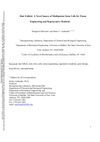Lrig1 Expression Defines a Distinct Multipotent Stem Cell Population in Mammalian Epidermis
May 2009
in “
Cell stem cell
”
TLDR Lrig1 marks a unique group of stem cells in mouse skin that can become different skin cell types.
The study identified Lrig1 as a marker for a distinct population of multipotent stem cells in the mouse epidermis, specifically in the hair follicle junctional zone. Lrig1 was shown to maintain stem cell quiescence, and its loss led to increased stem cell proliferation and epidermal hyperproliferation. Lrig1-expressing cells were capable of differentiating into all adult epidermal lineages in skin reconstitution assays, but were primarily bipotent under normal conditions, contributing to the sebaceous gland and interfollicular epidermis. Activation of beta-catenin expanded the junctional zone and, in the absence of Lrig1, led to increased ectopic hair follicle formation. The findings suggested that Lrig1-positive cells represented a previously unidentified reservoir of interfollicular epidermal stem cells in adult mice.





